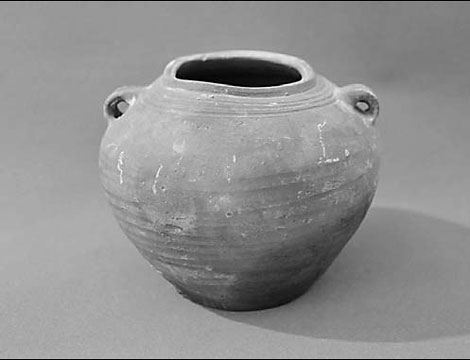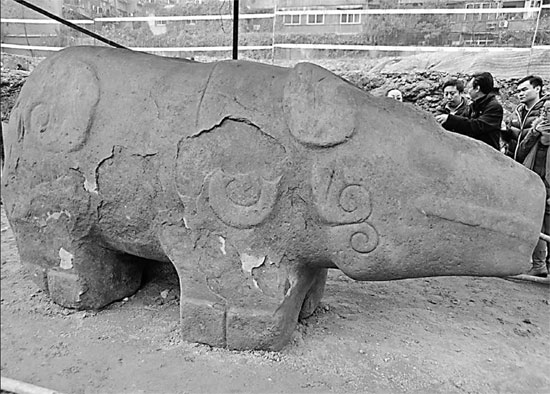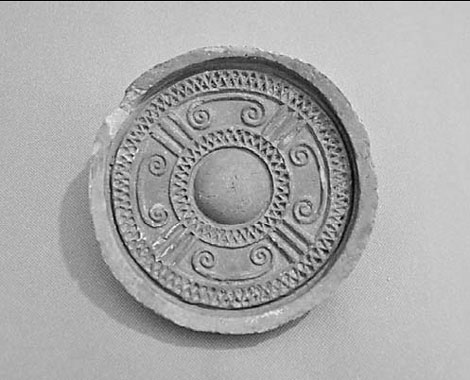Beast stone
Updated: 2013-02-18 08:05
By Huang Zhiling (China Daily)
|
||||||||
|
Visitors admire the stone rhino unearthed near the Tianfu Square in the heart of Chengdu. Photos by Yi Li / For China Daily |
An ancient stone rhino, recently excavated, has drawn scores of people to visit Jinsha Site Museum in Chengdu. Huang Zhiling with more details.
If you are walking on the streets of Chengdu, capital of Sichuan province, chances are you could be stepping on centuries-old treasures buried underneath.
Leaving no stones unturned, the Chengdu Archaeological Institute started archaeological excavations on the site of the Sichuan Grand Theater before constructions begin.
The site is near Tianfu Square in the heart of Chengdu.
Excavation works began in August 2012 and by the end of 2012, archaeologists had excavated an area measuring 4,300 square meters.
They found cultural relics dating back to the Warring States Period (475-221 BC), Han Dynasty (206 BC-AD 220), the Three Kingdoms Period (AD 220-280), Jin Dynasty (AD 265-420), Southern Dynasties (AD 420-589), Sui Dynasty (AD 581-618), Tang Dynasty (AD 618-907), Five Dynasties (AD 907-960), Song Dynasty (960-1279), Yuan Dynasty (1271-1368), Ming Dynasty (1368-1644) and Qing Dynasty (1644-1911).
Among their finds include ash pits, ash ditches, city walls, turrets, drains, houses, wells, building bases and lots of pottery, porcelain, iron and copper wares, coins and building materials such as eave tiles.
"The large quantity of exquisite eave tiles provides clues on the whereabouts of the royal palace of the Shu Kingdom in the Three Kingdoms Period," says Yuan Tingdong, an expert on Sichuan history and culture.
Of all the relics, the most conspicuous find is a gigantic stone beast, made from a single piece of red sandstone and looks like a rhino.
It is 3.3 meters long, 1.2 meters wide and 1.7 meters high and weighs about 8.5 tons.
The rhino has a conical head, round body and stubby limbs. Its ears, eyes, mandible and nose are still visible, and so are the patterns of clouds on its body.
"According to the carving style, it might have been made in the period between the State of Qin (9th century BC-221BC) and the Han Dynasty," says Yi Li, who is in charge of the archaeological excavations at the site of Sichuan Grand Theater.
When the stone rhino was found in the pit, it was in a sideway position with its limbs facing outwards, instead of in a standing position.
"The rhino might have been pushed into the pit in the early Jin Dynasty after the Shu Kingdom was toppled during the Three Kingdoms period, for the Jin ruler wanted to wipe out the cultural influence of the Shu Kingdom," Yi says.
The stone rhino is on display at Jinsha Site Museum in the city's western suburbs. The exhibition, which ends on Feb 28, has attracted thousands of visitors especially during the Spring Festival holidays.
Among them is Fu Changhua, an 87-year-old Chengdu resident.
"I have been looking forward to seeing the stone rhino for four decades," says Fu, a fervent lover of cultural relics. "When the city built the Chengdu Telecommunication Building in 1973, workers found the stone rhino but had to rebury it because they had only basic tools which could not pull the gigantic beast out," he says.
With more sophisticated tools now, archaeologists managed to excavate the treasure.
Researchers say its discovery can help explain what Tianfu Square, which is near the busiest commercial streets in Sichuan, was like in ancient days.
"As soft river sand was discovered in the pit where the stone beast was found, it can be inferred that the place used to be a river," says Lin Xiang, an 81-year-old professor of archaeology at Sichuan University.
Another expert, 82-year-old Feng Guanghong, says in ancient days, people believed that evil spirits feared the rhino.
A professor with the Sichuan Provincial Academy of Water Conservation, Feng opines that more than 2,000 years ago, Li Bing - an administrator of the State of Qin during the Warring States Period - built five stone rhino statues to suppress evil spirits that caused floods.
Wang Yi, chief of the Chengdu Archaeological Institute, says although the stone rhino is the earliest and largest round stone carving ever discovered in Sichuan, further studies are needed to establish the link between the stone rhino and Li Bing.
According to Zhu Cheng, a famous sculptor in Sichuan, the stone rhino is a rarity.
"It's rare for people in the olden days to use primitive tools to create such a work of art on a single piece of stone," he says.
There is an old saying related to Zhang Xianzhong (1606-47), a leader of a farmer's revolt who established the Daxi kingdom in Chengdu in 1644 after the fall of the Ming Dynasty, that goes: "If one finds a stone ox and a stone drum, he can find silver which can buy half of Chengdu."
According to one legend, Zhang buried his treasure trove and marked it with a stone ox and a stone drum before he fled Chengdu, when the Manchus attacked him.
"The word rhino reads xi niu in Chinese. Niu means ox in Chinese. So, many visitors associate the stone rhino with the stone ox in the old saying and visit the Jinsha Site Museum," says Fu Changhua, the Chengdu resident, on why the exhibition has attracted so many visitors.
Contact the writer at huangzhiling@chinadaily.com.cn.
|
The newly excavated relics include an eave tile (above) dating back between the late Eastern Han Dynasty (AD 25-220) and the Three Kingdoms Period (AD 220-280), and a Southern Dynasty (AD 420-589) pottery (below). |

(China Daily 02/18/2013 page20)

 In Photos: 7.0-magnitude quake hits Sichuan
In Photos: 7.0-magnitude quake hits Sichuan
 Li Na on Time cover, makes influential 100 list
Li Na on Time cover, makes influential 100 list
 FBI releases photos of 2 Boston bombings suspects
FBI releases photos of 2 Boston bombings suspects
 World's wackiest hairstyles
World's wackiest hairstyles
 Sandstorms strike Northwest China
Sandstorms strike Northwest China
 Never-seen photos of Madonna on display
Never-seen photos of Madonna on display
 H7N9 outbreak linked to waterfowl migration
H7N9 outbreak linked to waterfowl migration
 Dozens feared dead in Texas plant blast
Dozens feared dead in Texas plant blast
Most Viewed
Editor's Picks

|

|

|

|

|

|
Today's Top News
Live report: 7.0-magnitude quake hits Sichuan, heavy casualties feared
Boston suspect cornered on boat
Cross-talk artist helps to spread the word
'Green' awareness levels drop in Beijing
Palace Museum spruces up
First couple on Time's list of most influential
H7N9 flu transmission studied
Trading channels 'need to broaden'
US Weekly

|

|









